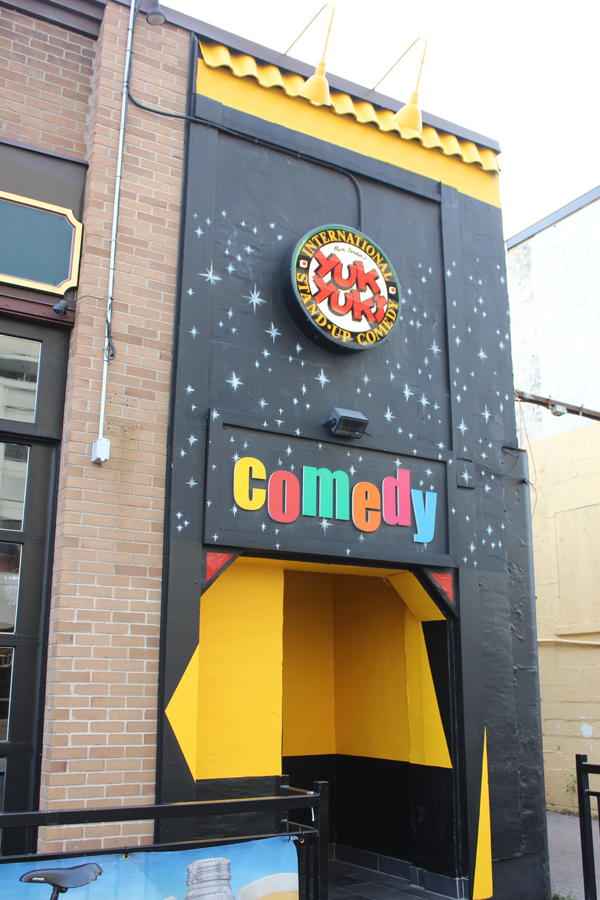The terms and conditions of public spaces
As temperatures drop and many of us search for the trendiest shackets and puffer jackets, others are searching for shelter amidst anti-homeless architecture. On your way to the Rideau Centre, you will pass many edifices created specifically to leave houseless populations sleepless in Sandy Hill.
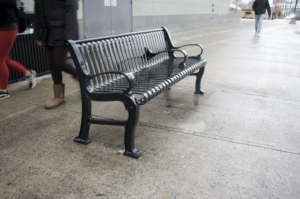
These hostile urban designs may take the shape of excessive armrests on park benches, studs on concrete, and other structures that fruitlessly deplete resources with the sole goal of creating discomfort for an already at-risk population. This is without a doubt the laziest way of targeting the real housing and homelessness crisis that has permeated Ottawa for more than 15 years.
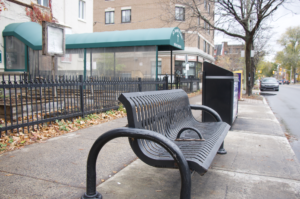
If this is the first you’re hearing of this, I’m sure it’s at least not the first you’ve seen it. These designs litter our streets unbeknownst to us. Upon seeing a bench of this design on campus, I started scrutinizing public spaces for such architecture and have been disappointed to find them decorating the streets of Byward, Sandy Hill, and the whole of Ottawa alike.
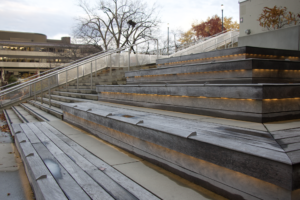
Consequently, it is clear that the term ‘public’ space is followed by an invisible asterisk. Apparently, like everything that exists in modernity, urban spaces are accompanied by a set of elusive terms and conditions. They are illicit, quietly whispering to the unhoused populations of urban spaces: “you don’t belong here.”
Urban design of this nature is often referred to defensive, exclusive, or hostile architecture. Regardless of the nomenclature, it is incontestably a silent killer. Why not call it what it really is: anti-homeless and inhumane. What is defensive design other than sleep-prevention techniques and a waste of resources? Rather than ignore the problem, why not acknowledge it and structure public spaces accordingly and practically? Architecture of this nature won’t create change. Policy reform creates change. Services create change. An extra railing here and there? No such luck.
As a homeless person living on the streets of Ottawa, Cristina Dufaure is familiar with defensive architecture and deplores it as “disgusting” and “sad”, as she stated in an interview.
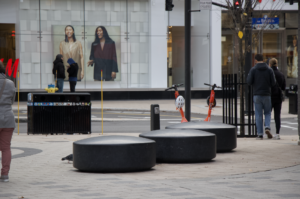
“That’s disgusting. That’s sad. Where else are we supposed to go when the shelters are full? We need to find nooks and crannies like that, that keep us warm at night, and they’ve barricaded them all with big spiky things and all these wooden pieces that block you out,” continued Dufaure. “Some people have to resort to panning a little bit of money to sit inside a 24/7 Tim Hortons to sleep inside. It’s not right. I don’t think they should be allowed. There are places in other cities that have homeless shelter benches and I think they should do that here and in every city.”
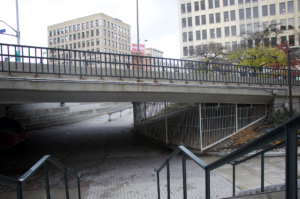
In order to eradicate these eyesores of anti-homelessness in our city, we must recognize them and deplore them. In Toronto and Montreal, public criticism of hostile urban design has successfully resulted in their removal. A bar structure outside Toronto General Hospital and spikes outside a department store in Montreal were both removed after they underwent scrutinization on social media.
Such is the power of social media and why initiatives like #defensiveTO are incredibly valuable to exterminating physical manifestations of anti-homelessness from our locale. This social media campaign documents the use of hostile architecture in the Greater Toronto Area and has been adopted by nations worldwide.
A hashtag like this has the power to incite social movements that force accountability from the implementors of these exclusive urban designs. I encourage residents of Ottawa to follow suit and force such culpability in their own city — once you know what to look for, you will regrettably find it on nearly every street corner.
Anti-homelessness manifests in many ways in urban cities. By-laws have the capacity to disproportionately target populations without homes by way of panhandling, soliciting, disorder, loitering, and obstructing neo-vagrancy offences. Toronto, in particular, boasts of far too many of these such by-laws, rendering it to be “against the law to be poor,” in that the impoverished are hyper-policed.
This issue permeates Canada and nations in its likeness, as depicted by the Policing and Homelessness Initiative’s depiction of neo-vagrancy laws across Canada. 75 per cent of Canadians live in a jurisdiction with a neo-vagrancy offence. Ottawa does not seem to implement by-laws of this nature, as people living on the streets of the nation’s capital have shared that they have had varyingly amicable experiences with policing.
“Ottawa’s pretty good that way. They don’t bother us at all. I’ve never been bothered,” shared John Arsenault, a member of Ottawa’s homeless, in an interview.
“Cops used to be really hard on it,” stated Dufaure when asked about how local by-laws surrounding panhandling and soliciting affect homeless populations. She continued to say that she is able to panhandle without a problem so long as she’s “not causing any issues.”
“Cops are hard, depending on where you are in the city. They’ll boot you off private properties near restaurants, banks, post offices, anywhere where there are large amounts of money coming in and out,” resolved Dufaure.
What is most frustrating to me about anti-homeless architecture of this nature is the waste of resources. Rather than funnel money into incorporating an extra railing to keep homeless people from having a place to sleep, why not invest in programs that would help mitigate homelessness?
John Arsenault has been homeless since splitting with his wife and the death of his son, and is now “in the middle of Ottawa, trying to make a couple dollars.”
“It would be nice if there were more services for the homeless. They do have quite a bit here for the homeless, compared to other cities, but there’s always room for improvement as far as housing and stuff. It’s hard to find housing when you’re homeless. If you have a home, it’s easier to find a home. So, yeah, it would be nice to have more opportunities to find a home,” concluded Arsenault in an interview.
Like Arsenault, Dufaure emphasizes the cyclical nature of homelessness and the systemic nature in which people without homes are obstructed from entering homeownership and tenancy.
“I don’t think renters should be able to refuse you because you’re homeless. I mean, most people looking for units are either homeless or on the verge of it and it’s sickening,” stated Dufaure. “Maybe if they built more affordable housing and had more programs, like subsidized housing that had more funding, we would be able to rent decent apartments.”
Like housing services, investing in mental health resources would be a more efficient and effective use of resources.
Saul Alvaresaverris is not from Ottawa, but ended up living on Rideau Street after a journey with addiction.
“This is the first time I’ve got help. I just got diagnosed with PTSD, which does help. I chose to get that help and getting real help, it takes a long time — there’s a long waiting list,” affirmed Alvaresaverris in an interview.
“If you end up homeless, you cannot get the right help that you need to improve yourself as a person and keep going in life like a regular person. Mental health is a big issue for people that end up as homeless because they just cannot deal with their mental illness and addiction,” continued Alvaresaverris. “Me, myself, I medicate myself because now I’m waiting for help. Getting medication, or therapy — it’s hard. Either you have to wait — or you cannot afford [it]. It’s a lot of money. It’s like six months to a year waiting list, so, really, it’s what you have to do to survive, you know?”
It is this exact lack of resources that keeps people on the streets. This cycle of poverty and homelessness is what we should be seeking to stop in its tracks, which is only possible through real systemic change and the implementation of services that support at-risk populations.
“Mental health and addiction affect us all,” asserted Dufaure. “I ended up in a Canadian Mental Health Association. They had a unit for me and it was full of cockroaches. There were bedbugs in that place — in that building. I have dealt with immense amounts of flooding — and, like, there’s nowhere good,” stressed Dufaure in an interview.
With a large homeless population in Canada and Ottawa alone, this problem is not one that can be ignores. The Ottawa Mission has been operating at more than 100 per cent capacity for more than three years. Moreover, prior to the pandemic, the City of Ottawa “declared a housing and homelessness emergency, yet we still have over 12,000 households on the waitlist for social housing,” wrote Bader Abu-Zahra in a statement to the Fulcrum, and the situation has reportedly only worsened.
The housing and homelessness crisis is not one we can ignore, nor can we fix it with Band-Aid solutions like that of anti-homeless architecture. If your goal is to keep homeless people off the streets of Ottawa, your best bet is not extra railings nor studded concrete to incite discomfort, but rather real, tangible change that eliminates roadblocks obstructing homeless individuals from getting the help they need.







